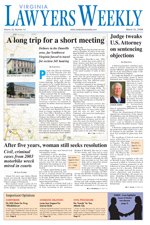You probably don’t have this much interest in interest.
The Supreme Court of Virginia takes 49 pages, including a five-page concurrence, to untangle the mess created by two jury trials, two earlier appeals, the specification by a jury of an interest rate higher than the one the trial court allowed, and the possible accrual of post-judgment interest on pre-judgment interest.
The bad news is that wading through Upper Occoquan Sewage Authority v. Blake Construction Co. may well become the first step toward resolving any dispute in which interest is an issue.
If the case doesn’t satisfy your civil procedure jones, try Ahari v. Morrison, in which plaintiff filed an amended complaint and a motion to for leave to amend three days before the statute of limitations expired. The trial judge took two months to act on the papers. The defendants contended that the amended complaint was filed outside the statute because the date of filing is the date the court acts on the motion, not the date it is filed with the clerk.
Because Rule 1:8 requires leave of court to amend any pleading after it is filed, the defendants are correct, the court ruled.
Subscribe to:
Post Comments (Atom)

No comments:
Post a Comment